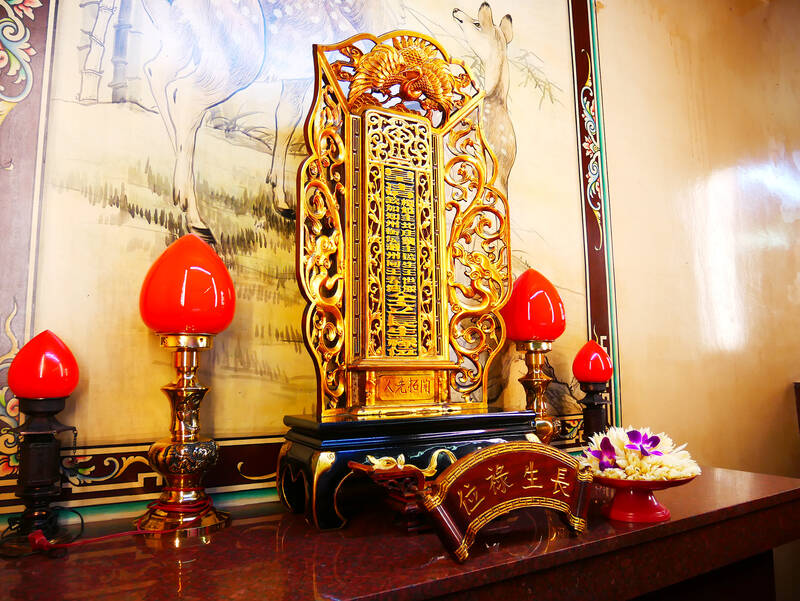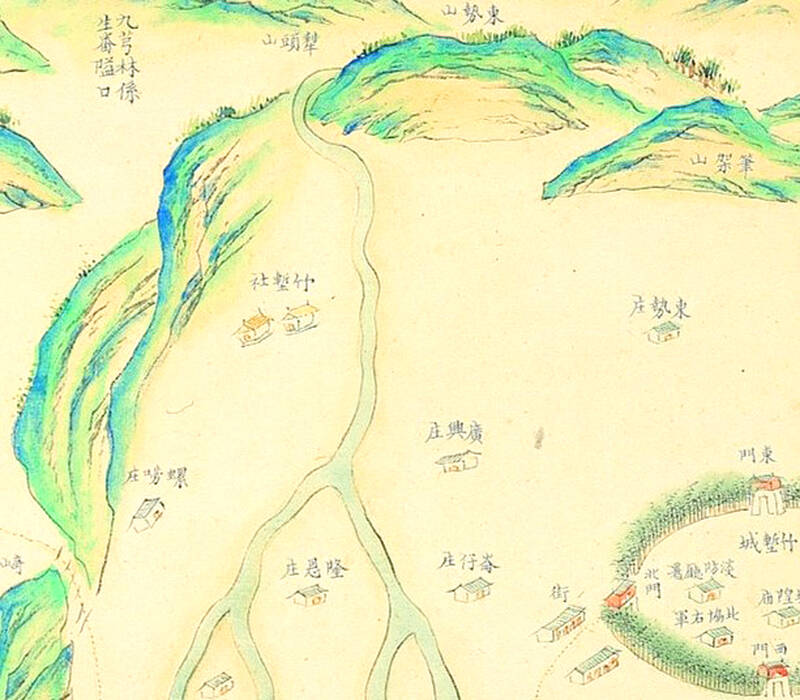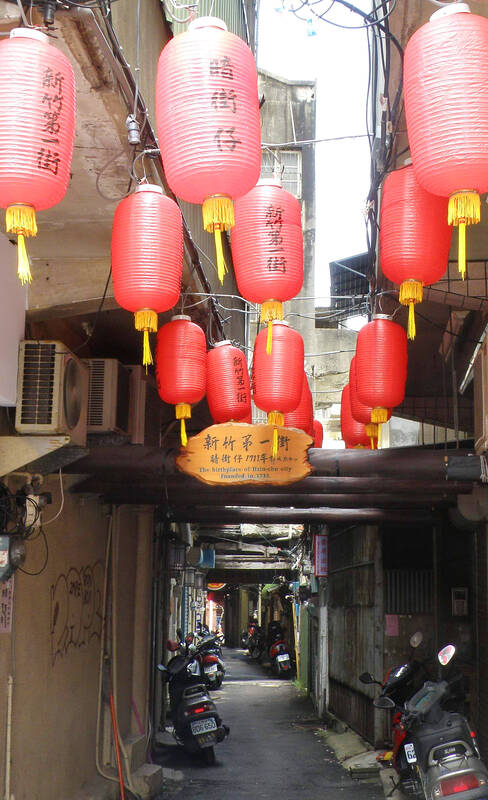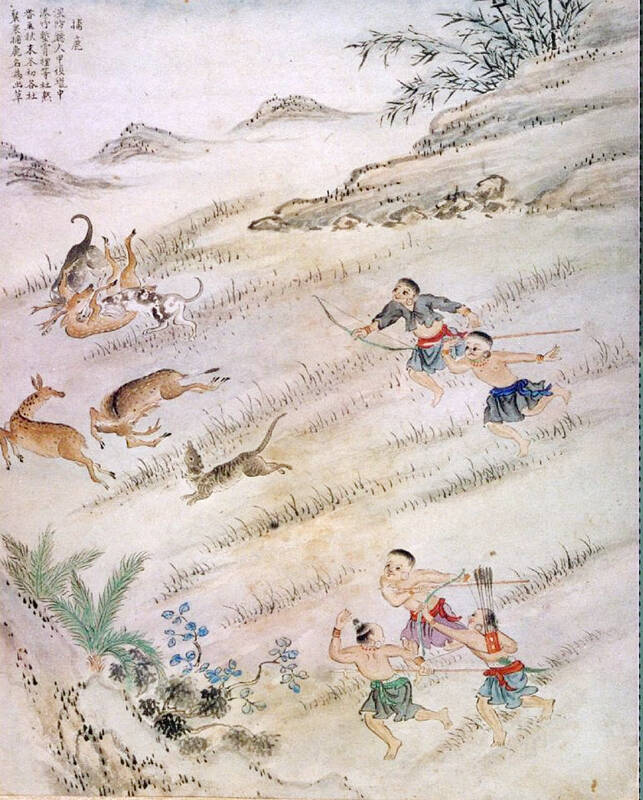Oct. 3 to Oct. 9
Wang Shih-chieh (王世傑) could not forget the fertile plains he saw on his trip north. He first passed by in 1682 while delivering food supplies to Kingdom of Tungning troops, who were suppressing indigenous unrest in northern Taiwan.
More than a decade later, the Kinmen native returned with over 180 settlers from his home village, establishing a prosperous settlement that became today’s Hsinchu City. The place they first set up camp is at Lane 36 Dongqian Street (東前街), which is designated Hsinchu’s first street and the birthplace of the city. The sign says they arrived in either 1691, 1701, 1711 or 1718.

Photo courtesy of Wikimedia Commons
Wang constructed the Longen Canal (隆恩圳), one of three ancient waterways in town, and several temples that still stand today. Many sources state that he died on Oct. 5, 1721 during a trip home, but some maintain that he was beheaded by an indigenous robber on the same date while inspecting the canal. In any event, his relatives were said to have made a head from gold, attached it to the body and sent it back home to rest in the ancestral grave.
Obviously there were indigenous people living in this area already, but the sign doesn’t mention them at all. A Hsinchu Bureau of Cultural Affairs document notes that Wang traded with them and established boundaries between the two groups, and farmed initially on abandoned indigenous land.
Who were these original inhabitants, what happened to them and how exactly did Wang die? Taiwan in Time investigates.

Photo: Hung Mei-hsiu, Taipei Times
STRONGMAN
An 1995 article in Hsinchu Journal of History (竹塹文獻) by Wang’s ninth-generation descendent Wang Chia-tsan (王家燦) confirms that Wang was born in 1624 in Jincheng (金城) in today’s Kinmen. The warlord and Ming loyalist Cheng Cheng-kung (鄭成功, or Koxinga) was based in Kinmen before dislodging the Dutch from Taiwan, and Wang joined his army at some point. He was in charge of protecting the grain supplies for Cheng’s Tainan-based Kingdom of Tungning.
Wang was rewarded with cultivation rights after successfully delivering food supplies to the troops in 1682, and he chose the piece of fertile land he saw on the way. He returned to Kinmen and began recruiting settlers, but the Qing Dynasty’s annexation of Taiwan in 1683 delayed his plans. They arrived sometime between 1691 and 1718, and set up basic huts along “Hsinchu’s first street.”

Photo courtesy of Wikimedia Commons
This account notes that relations with indigenous Taokas were peaceful, noting that the areas indigenous inhabitants usually cultivated land for a few years before abandoning it and moving on, and these were the lands that Wang’s people initially farmed on.
In the same publication, Chang Te-nan (張德南) discusses the settlement process in more detail. Even though Taiwan was under Qing rule, the closest government post was in Tamsui, and they had little jurisdiction over the hunting grounds for the Taokas in Hsinchu. As a result, Han settlers fended for themselves, with Wang acting as a strongman who maintained order and protected the settlement.
These strongmen either applied for cultivation rights from the government or purchased land directly from the indigenous and rented it to the settlers. The operation required considerable funds and strong leadership skills, and Wang’s empire continued to expand under his descendants.

Photo: Hung Mei-hsiu, Taipei Times
HOW DID WANG DIE?
Both articles maintain that Wang died from natural causes during a visit home. So do at least three other historic sources, including one copy of the Wang family genealogy book. Chang revisits the issue of Wang’s death in a 2018 article.
The source of Wang being murdered comes from 13th generation descendant Wang Shih-kun (王世焜), who manages his ancestor’s old residence in Kinmen. He notes that Wang’s grave has been called the “golden head ancestral tomb” by the family for generations.

Photo courtesy of Wikimedia Commons
The story matches one written by Lan Ting-yuan (藍鼎元), a Qing military officer who came to Taiwan to suppress a peasant rebellion led by Chu Yi-kuei (朱一貴) in 1721, the same year Wang died. While passing through Hsinchu, Lan noticed that the streets were especially empty. He learned it was because someone had been beheaded by an indigenous robber and residents were afraid to leave their homes.
Chang thinks this story apocryphal; indigenous attacks were not uncommon in those days, and there had been no record of this story in Kinmen until the government began researching Wang’s tomb and residence in 2005. Furthermore, Chang argues that traditional bone-pickers (撿骨師) called the remains “golden bones” (金骨) out of reverence, and such reburials were often called “golden auspicious burials” (黃金吉葬).
FALL OF THE TAOKAS
The Taokas were the dominant group in the area, and their territory, commonly referred to as Jhuchien (竹塹社, Tek-kham in Hoklo), was called Pocael by the Dutch. Jhuchien was also one of the names of the area’s walled city until it was officially renamed Hsinchu in the 1870s.
According to local accounts, the Taokas got along with the early settlers and often farmed side by side. But farming was not their expertise as they were previously hunters and fishers, and they quickly declined in power.
After accepting Qing rule around 1700, the Taokas were subjected to heavy taxes, which they paid by selling deer skins. This led to overhunting, and in 1715, Qing official Ruan Tsai-wen (阮蔡文) wrote a poem about the dwindling deer supply and how more than half of the Taokas traditional hunting grounds were now occupied by Han farmers. He described how the Taokas struggled to match Han productivity, and some were so poor they couldn’t even start a family.
Many opted to rent or sell their land to the settlers instead, but after the tenants grew prosperous enough, they often seized the land as their own. Some Taokas were able to get by and acculturate to this new life, and continued to live in small settlements while maintaining their language and customs.
In 1724, the Qing emperor allowed people to settle in the Hsinchu area en masse, later permitting them to bring their wives and children. By the mid-1700s, Han settlers had completely overrun the area.
After finally reducing their taxes in 1737, the Qing established in 1750 a Taokas-only reserve for them to hunt and farm. They also gave them special land renting rights. However, they accelerated their cultural loss by ordering them to adopt Qing hairstyles and dress and giving them one of seven Chinese surnames to use.
The Qing boundaries could not stop Han encroachment, however, and many opted to leave the area. Intermarriage was common, and an 1888 census shows that the 158 remaining Taokas in Jhuchien were “indistinguishable” from the Han.
The Taokas mostly registered as Han during the Japanese census, but continued to use the Taokas language during ancestor worship ceremonies until 1966, when the last person who knew the words died. Today, a Taokas cultural revival movement is based in Miaoli County’s Singang Village (新港).

This month the government ordered a one-year block of Xiaohongshu (小紅書) or Rednote, a Chinese social media platform with more than 3 million users in Taiwan. The government pointed to widespread fraud activity on the platform, along with cybersecurity failures. Officials said that they had reached out to the company and asked it to change. However, they received no response. The pro-China parties, the Chinese Nationalist Party (KMT) and Taiwan People’s Party (TPP), immediately swung into action, denouncing the ban as an attack on free speech. This “free speech” claim was then echoed by the People’s Republic of China (PRC),

Exceptions to the rule are sometimes revealing. For a brief few years, there was an emerging ideological split between the Democratic Progressive Party (DPP) and Chinese Nationalist Party (KMT) that appeared to be pushing the DPP in a direction that would be considered more liberal, and the KMT more conservative. In the previous column, “The KMT-DPP’s bureaucrat-led developmental state” (Dec. 11, page 12), we examined how Taiwan’s democratic system developed, and how both the two main parties largely accepted a similar consensus on how Taiwan should be run domestically and did not split along the left-right lines more familiar in

As I finally slid into the warm embrace of the hot, clifftop pool, it was a serene moment of reflection. The sound of the river reflected off the cave walls, the white of our camping lights reflected off the dark, shimmering surface of the water, and I reflected on how fortunate I was to be here. After all, the beautiful walk through narrow canyons that had brought us here had been inaccessible for five years — and will be again soon. The day had started at the Huisun Forest Area (惠蓀林場), at the end of Nantou County Route 80, north and east

Specialty sandwiches loaded with the contents of an entire charcuterie board, overflowing with sauces, creams and all manner of creative add-ons, is perhaps one of the biggest global food trends of this year. From London to New York, lines form down the block for mortadella, burrata, pistachio and more stuffed between slices of fresh sourdough, rye or focaccia. To try the trend in Taipei, Munchies Mafia is for sure the spot — could this be the best sandwich in town? Carlos from Spain and Sergio from Mexico opened this spot just seven months ago. The two met working in the